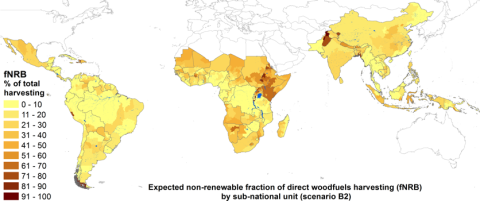Note: Yale School of the Environment (YSE) was formerly known as the Yale School of Forestry & Environmental Studies (F&ES). News articles and events posted prior to July 1, 2020 refer to the School's name at that time.

The harvesting of wood to meet the heating and cooking demands for billions of people worldwide has less of an impact on global forest loss and carbon dioxide (CO2) emissions than previously believed, according to a new Yale-led study.
Writing in the journal Nature Climate Change, a team of researchers, including Prof. Robert Bailis of the Yale School of Forestry & Environmental Studies (F&ES), concludes that only about 27 to 34 percent of wood fuel harvested worldwide would be considered “unsustainable.” According to the assessment, “sustainability” is based on whether or not annual harvesting exceeds incremental re-growth.
The other authors are Rudi Drigo, an independent forestry specialist with international experience; and Adrian Ghilardi and Omar Masera of the National Autonomous University of Mexico.
According to the authors, the findings point to the need for more nuanced, local-specific policies that address forest loss, climate change, and public health. They also suggest that existing carbon offset methodologies used to reduce carbon emissions likely overstate the CO2 emission reductions that can be achieved through the promotion of more efficient cookstove technologies.
The study identifies a set of “hotspots” where the majority of wood extraction exceeds sustainable yields. These hotspot regions — located mainly in South Asia and East Africa — support about 275 million people who are reliant on wood fuel.
Writing in the journal Nature Climate Change, a team of researchers, including Prof. Robert Bailis of the Yale School of Forestry & Environmental Studies (F&ES), concludes that only about 27 to 34 percent of wood fuel harvested worldwide would be considered “unsustainable.” According to the assessment, “sustainability” is based on whether or not annual harvesting exceeds incremental re-growth.
The other authors are Rudi Drigo, an independent forestry specialist with international experience; and Adrian Ghilardi and Omar Masera of the National Autonomous University of Mexico.
According to the authors, the findings point to the need for more nuanced, local-specific policies that address forest loss, climate change, and public health. They also suggest that existing carbon offset methodologies used to reduce carbon emissions likely overstate the CO2 emission reductions that can be achieved through the promotion of more efficient cookstove technologies.
The study identifies a set of “hotspots” where the majority of wood extraction exceeds sustainable yields. These hotspot regions — located mainly in South Asia and East Africa — support about 275 million people who are reliant on wood fuel.
If forests and woodlands would have been cut down anyway, then the projects designed to reduce wood fuel demand are not actually going to reduce deforestation.
However, in other regions, the authors say, much of the wood used for this traditional heating and cooking is actually the byproduct of deforestation driven by other factors, such as demand for agricultural land, which would have occurred anyway.
“If forests and woodlands would have been cut down anyway, then the projects designed to reduce wood fuel demand are not actually going to reduce deforestation,” said Bailis, an associate professor at F&ES and lead author of the study. “Sure, you’re reducing wood use, but the underlying pressures driving deforestation are still out there.”
The results stand in contrast to a long-held assumption that the harvesting of wood fuels — which accounts for more than half of the wood harvested worldwide — is a major driver of deforestation and climate change.
Using a model originally developed by Drigo and Masera, and already applied in more than 20 countries, the researchers produce a spatially explicit snapshot of wood fuel supply and demand in 90 countries across the world’s tropical regions, where burning wood is a critical source of energy for cooking and heating.
“One of the problems with traditional bio-energy is that the situation is very locally specific, so you can’t come up with a general response for all places,” said Masera. “One of the real strengths of this paper is that it demonstrates a methodology that allows you to identify priority regions for intervention”
“If forests and woodlands would have been cut down anyway, then the projects designed to reduce wood fuel demand are not actually going to reduce deforestation,” said Bailis, an associate professor at F&ES and lead author of the study. “Sure, you’re reducing wood use, but the underlying pressures driving deforestation are still out there.”
The results stand in contrast to a long-held assumption that the harvesting of wood fuels — which accounts for more than half of the wood harvested worldwide — is a major driver of deforestation and climate change.
Using a model originally developed by Drigo and Masera, and already applied in more than 20 countries, the researchers produce a spatially explicit snapshot of wood fuel supply and demand in 90 countries across the world’s tropical regions, where burning wood is a critical source of energy for cooking and heating.
“One of the problems with traditional bio-energy is that the situation is very locally specific, so you can’t come up with a general response for all places,” said Masera. “One of the real strengths of this paper is that it demonstrates a methodology that allows you to identify priority regions for intervention”
 The study identified a set of “hotspot” regions in South Asia and Eastern Africa where the majority of wood extraction exceeds sustainable yields.
The study identified a set of “hotspot” regions in South Asia and Eastern Africa where the majority of wood extraction exceeds sustainable yields.
In addition to the global analysis, the researchers are using the same model to evaluate the sustainability of wood fuel resources in three case studies: Honduras, Kenya, and the Indian state of Karnataka.
“Even within a given country the situation varies a great deal,” said Drigo. “Some areas are over-exploited while others are under-exploited or totally untouched. A better understanding of the relationship between supply and demand requires this type of spatial approach to clarify what the impacts of different policies will be.”
Emissions from wood fuels account for about 1.9 to 2.3 percent of global emissions, the study says. The deployment of 100 million improved cookstoves could reduce this by 11 to 17 percent, said Bailis, who also studies the factors that influence the adoption of cleaner cookstoves in developing nations.
These reductions would be worth more than $1 billion per year in avoided greenhouse gas emissions if black carbon were integrated into carbon markets, he said.
“We need to be able to understand where these different components of non-renewability are coming from in order to get a better sense of the positive impacts of putting stoves into peoples' homes or promoting transitions to cooking with gas or electricity,” he said.
The research was funded by the Global Alliance for Clean Cookstoves, an initiative supported by the UN Foundation.
“Even within a given country the situation varies a great deal,” said Drigo. “Some areas are over-exploited while others are under-exploited or totally untouched. A better understanding of the relationship between supply and demand requires this type of spatial approach to clarify what the impacts of different policies will be.”
Emissions from wood fuels account for about 1.9 to 2.3 percent of global emissions, the study says. The deployment of 100 million improved cookstoves could reduce this by 11 to 17 percent, said Bailis, who also studies the factors that influence the adoption of cleaner cookstoves in developing nations.
These reductions would be worth more than $1 billion per year in avoided greenhouse gas emissions if black carbon were integrated into carbon markets, he said.
“We need to be able to understand where these different components of non-renewability are coming from in order to get a better sense of the positive impacts of putting stoves into peoples' homes or promoting transitions to cooking with gas or electricity,” he said.
The research was funded by the Global Alliance for Clean Cookstoves, an initiative supported by the UN Foundation.
The original paper:
Bailis, Robert; Drigo, Rudi; Ghilardi, Adrian; and Masera, Omar. 2015. The carbon footprint of traditional woodfuels. Nature Climate Change. doi:10.1038/nclimate2491
– Kevin Dennehy kevin.dennehy@yale.edu 203 436-4842
Published
January 22, 2015